Review: V5.12 Hangboard from Detroit Rock Climbing Company (Still Available at Escape Climbing)
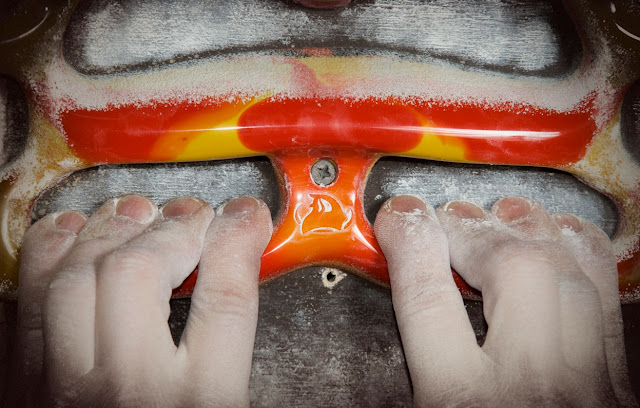
Editors Note: Sadly, the DRCC is no longer in business, but their molds were purchased by Escape Climbing, including this board. You can now find it, a little cheaper than it was in 2011 (!) but now called The Beta Board, at their site.
If you've seen, or been lucky enough to climb on any of the dual textured holds created by the DRCC, then you're already aware that they serve two important functions. First, they force you to use only a specific part of the grip, which saves your skin and makes you strong. Second, they are so finely finished that I have no problem calling them art. In fact, they are almost too pretty to climb on. Almost.
But a dual textured hangboard? Since you only use specific parts of the grips anyway, is there really a point to having the dual texture? While looking at pictures I couldn't concoct a reason that satisfied me, so I contacted the sculptor, Vincent Cocciolone, and he happily sent me one of the boards to check out for myself.

My immediate reaction when I opened the box was that the board was finished even nicer than I had imagined from the photos. The smooth portion of the dual texture has a high gloss, almost mirror like quality. Basically, it's sexy. A little pre-hang fondling and the purpose of the dual texture started to reveal itself. The textured areas are not an even grit, but a more gradual one. The deepest texture, which I still find to be friendly, is at the back of the hold, where your fingertips will appreciate it. Toward the front of the hold, the polish begins to take over, leaving no opportunity for folding skin to hold you off of the floor. It's all grip on this one... no cheating.
Also out of the box, I was surprised by the size and shape of some of the holds. They were smaller than I had expected, and two of the smallest were rounded, sloping edges, which most hangboards I've used seem to ignore. All of the grips have plenty of room to accommodate all 4 fingers, or in the case of the slopers, both hands. And yes, it has pinches. Since I'd never seen a hangboard with effective pinches, I was anxious to get the thing on the wall and hang around on it.
I hung the board at they gym where I train, Rockquest, so that I could solicit the thoughts of several other dedicated climbers. Screwed up onto our new boulder, the V5.12 not only made an eye catching statement, but it did something I hadn't expected. While normally I see people use hangboards as a pullup station, several climbers actually asked me HOW to use it. It seems that with form, came the expectation of function. I had experienced something similar with the popular Moon Board, though most found the holds on the Moon Board too small to even begin to use. The V5.12 is more geared toward the climber looking to break into the V5 or 5.12 grades, hence the name. I'll go a step further and say that the board is just about perfect for training the finger strength of climbers from beginner to pushing into the 5.13 realm, and with a little ingenuity, beyond that.
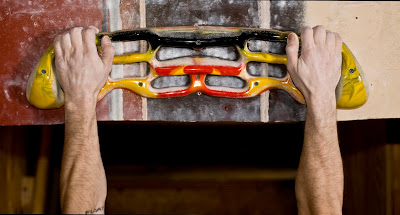
So lets look at how the holds themselves breakdown. As is standard for most boards, there are two jugs at the top (my hands are on them in the photo to the right). I'm often dismayed at how sharp the largest holds on many hangboards can be. Not these.
The DRCC took care to make all of the holds comfortable, and the radii on the edge of these little 1-1/2" buckets is the best I've used on an incut hold that's thin enough to force you to "hold" it. Just inside of the jug is a flat edge that is also 1-1/2" deep. At top center is a big sloper that is 2" of texture before it fades into the unusable gloss finish.
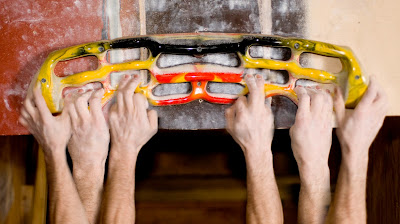
Moving down to the 2nd row, on the outside we find a 1-1/4" incut finger bucket. Watching beginners on the board, I was continually surprised by the difference that 1/4" can make on an incut hold. Mimicking the top row, just inside the finger bucket is a flat hold that measures 1-1/8". The middle of this row houses a 1-1/4" sloper that is quite a bit more difficult to use than it's big brother on the first row. This row, in my opinion, is where the beginner climber who wants to dabble in hangboard use will get their money's worth.
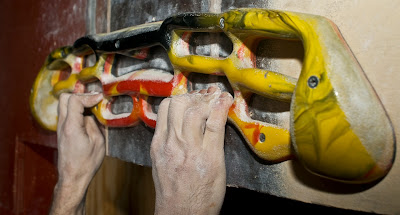
The bottom row is the meat and potatoes of this board, and where it really begins to shine for the climber pushing into the 5.12 range. All 3 of the edges measure about 1/2" of usable surface, give or take a 16th of an inch. Beginning on the outside and moving in, we have an incut edge, a flat edge, and a perfect little slopey edge. Even these small holds have enough room to fit all 4 fingers onto the edge.
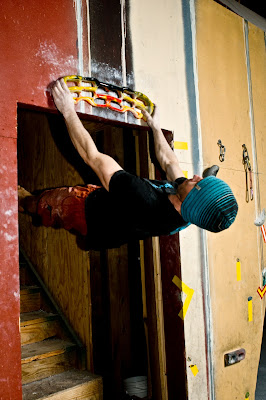
So what about the pinches? As pinches are one of my strengths, I find myself wishing that the pinches on every hangboard were worse. Watching several 5.9 - 5.11 climbers using the pinches on the DRCC board, it was apparent that they are just about right. I also found that if I didn't grip the pinch fully, and instead only the used the outer half inch or so, it became quite hard to hold, which is what I was looking for. For the climber whose pinch grip is among their weakest, these pinches (with two levels... think thumb in the upper "pocket" or thumb in the lower "pocket") will no doubt bring your pinches up to speed.
In searching for anything negative, my first instinct was "there are no pockets". It's true, there aren't.... but that is actually a positive. Pockets give the added friction on the sides of the hold, decreasing the amount of strength you need to use to hold the grip. Instead, I found that using the smallest holds as 2 finger edges was the training I was desperately missing out on with most other boards I've tried. For some reason (maybe the radii of the edges?), holding the small edges on other boards as a 2 finger seems to be something different than a "pocket" type grip.
The only con that I personally found, and this a tiny gripe, is that several of the edges have a slight outward "bulge" in the center, so the usable surface isn't uniform across the length of the hold. The centers of these holds are slightly deeper. When I mentioned this to another tester, he hadn't even noticed.
Only one of the other climbers using the board had a complaint, and he also admitted that he was reaching for negatives, saying that the "ergonomic" shape of the board (each side angling slightly downward from center) made it a little more difficult to use the outer holds with only one arm. It's interesting to note that this tester climbs V11 and was also surprised at how small the smallest holds felt.
Across the board, every climber using the board made the same, unsolicited comment... that the dual texture completely eliminated the problem of "rolling" skin. I also attribute this to the attention paid to the friendliness of the edges. None are too sharp, and the rounded edges quickly turn into that perfectly unusable gloss surface.
Above, I mentioned that a little ingenuity could make this board perfect for the stronger climber. Two simple changes could elevate this board to the V8/5.13. As you progress past the smallest holds, you could mount the board on a slight overhang, and the small edges would be instantly much harder to use. Also, because all of the holds go through the board (meaning that the "back" of the hold is the wall it is mounted on), one could easily add a "shim". Screwing a thin piece of wood, or just wedging a piece of cardboard into the back of the holds can decrease their usable surface to whatever you need.

In all, this board is a resounding success. I've not seen a board geared toward the V5/5.12 climber that is more friendly, more effective, or nicer looking. While it isn't as advanced as the popular Moon Board, with a couple of changes it could offer far more variety. For the climber who needs to train at home with limited time and space, long hard sessions on this board won't destroy your skin. With thin cardboard inserts on a couple of holds, it's become my go-to board when I'm in need of a "strength-endurance" sort of finger workout. And for those of you who can't keep your New Years resolutions, it will make a gorgeous piece of sculpture to mount on your wall.
If you're in Cincinnati, and want to try it out before I take it home and hoard it for myself, its hanging on The Anvil at Rockquest.
The Stats:
Price: $89.95
Mounting hardware: 10 screws, included.
Mounting board: Available at additional price.
Colors: Multi. Custom colors/patterns are available to order.
Grips: Two 1-1/2" incut jugs.
Two 1-1/2" flat edges.
Two 1-1/4" incut mini-jugs.
Two 1-1/8" flat edges.
Two 1/2" incut edges.
Two 1/2" flat edges.
Two 1/2" slopey edges.
One 2" sloper.
One 1-1/4" sloper.
Two thin pinches.
Two wide pinches.
** All photos from this blog thanks to Taylor Frohmiller.












If everything you do is a finger workout, then when do your hands get a chance to recover?